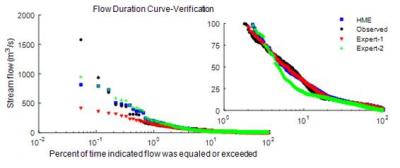Hydrologic Model Structural Uncertainty Reduced by a Hierarchical Mixture of Experts and Diagnostic Modeling Approach
Accounting for the uncertainty and dynamic nature of the multiscale interactions among diverse components of a hydrologic system requires a new strategy to effectively integrate hydrological processes.
This research provides useful tools to address model structural uncertainties in the multi-model and integrated modeling of the Earth system and the water-energy nexus.
In most water system model applications, any particular model structure may not be sufficient to capture the dynamic multi-scale interactions among different hydrological processes. An alternative option is to develop local expert model structures (i.e., through a formal statistical approach, based in Bayesian theory) corresponding to dominant components of the hydrological process and integrate them through exchanges of variables. Researchers from Washington State University and the Department of Energy at Pacific Northwest National Laboratory developed such a Hierarchical Mixture of Experts (HME) framework to dynamically integrate expert models (e.g., groundwater and runoff models) in the presence of multiple dominant processes, as revealed by carefully designed signature diagnostic analyses. The framework allows integrating expert models by using adaptive weights, which vary depending on the dominant processes at any given time and spatial location. They applied this framework on two distinct watersheds, one from North Carolina and another from Texas. They showed that while a single model is adequate for the North Carolina watershed dominated by homogeneous processes, the HME approach significantly improved the simulation performance compared to the single model for the Texas catchment that has multiple dominant processes. This study provides useful tools to address model structural uncertainties in the multi-model and integrated modeling of the Earth system and the water-energy nexus.

